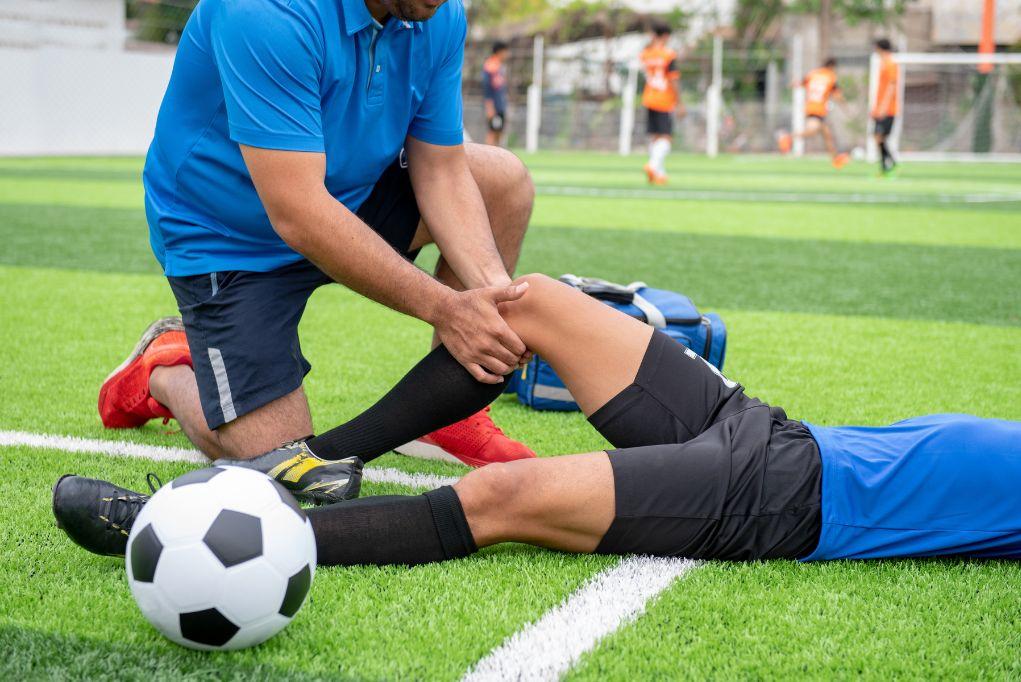High Ankle Sprain: What Makes It Different from a Regular Sprain?
Ankle sprains are one of the most common sports injuries, but not all sprains are the same. If you’ve been told you have a high ankle sprain, you may be wondering how it differs from the more familiar low ankle sprain and why recovery often takes longer.
While both injuries involve damage to the ligaments that stabilize the ankle, a high ankle sprain affects a completely different set of ligaments and typically results from a more forceful, twisting injury.
Let’s explore what a high ankle sprain is, how it happens, how it differs from a regular sprain, and what recovery looks like.

What Is a High Ankle Sprain?
A high ankle sprain, also known as a syndesmotic ankle sprain, occurs when there is damage to the ligaments that connect the two bones of the lower leg: the tibia and fibula. These ligaments form what’s called the syndesmosis, which holds the bones tightly together above the ankle joint.
Unlike a typical ankle sprain, which affects the ligaments on the outside of the ankle (like the anterior talofibular ligament), a high ankle sprain occurs higher up and often involves more severe injury.
What Causes a High Ankle Sprain?
High ankle sprains are most commonly caused by a twisting or rotational injury, especially when the foot is planted and the leg rotates outward. This type of motion places extreme stress on the syndesmotic ligaments.
Common causes include:
- Sudden pivoting or cutting motions in sports like football, soccer, basketball, or skiing
- Getting hit from the side while your foot is planted
- Falling awkwardly while running or jumping
Athletes and active individuals are especially prone to high ankle sprains due to the high-speed, multi-directional nature of their movements.
High Ankle Sprain vs. Regular Ankle Sprain: What’s the Difference?
The biggest difference lies in the location and severity of the injury.
| Regular Ankle Sprain | High Ankle Sprain | |
|---|---|---|
| Ligaments involved | Lateral ligaments (outside of ankle) | Syndesmotic ligaments (between tibia and fibula) |
| Common cause | Inward rolling of the ankle (inversion) | Outward twisting of the foot and leg |
| Symptoms | Swelling, bruising, pain around ankle | Pain above the ankle, especially with rotation or walking |
| Healing time | 2–4 weeks (mild cases) | 6+ weeks |
High ankle sprains typically take longer to heal and may result in more instability if not properly diagnosed and treated. It’s also worth noting that these injuries are sometimes missed on initial exams because swelling is less obvious than in a typical sprain.
Symptoms of a High Ankle Sprain
Symptoms may vary depending on the severity, but common signs include:
- Pain above the ankle, between the tibia and fibula
- Increased pain when rotating the foot outward or walking uphill
- Difficulty bearing weight on the injured leg
- Mild to moderate swelling (not always visible)
- Tenderness when pressing above the ankle joint
- Instability or a feeling that the ankle is going to “give out”
Because high ankle sprains don’t always produce the same swelling and bruising as low ankle sprains, it’s important not to dismiss the pain as minor.
Diagnosing a High Ankle Sprain
At Motion Orthopaedics, we begin with a physical exam and assess for key indicators like:
- Pain during the squeeze test (pressing the tibia and fibula together)
- Pain during the external rotation test (rotating the foot outward)
- Imaging tests like X-rays (to rule out fractures) and MRI scans (to assess ligament damage) may be used to confirm the diagnosis and rule out more serious injuries.
Accurate diagnosis is essential. If a high ankle sprain is mistaken for a low ankle sprain and not given the right treatment, it can lead to chronic instability, limited performance, and long-term joint damage.
How Is a High Ankle Sprain Treated?
Non-surgical Treatment
Most high ankle sprains, especially mild to moderate ones, can be managed without surgery.
Common treatments include:
- Rest and activity modification
- Immobilization with a boot or brace to reduce movement between the tibia and fibula
- Ice and elevation to reduce swelling
- Anti-inflammatory medications to manage pain
- Physical therapy to restore strength, stability, and range of motion
Recovery can take 6 to 12 weeks or more, depending on severity. Returning to sports or high-impact activity too soon can increase the risk of reinjury.
Surgical Treatment
In severe cases, such as complete ligament tears or associated fractures, surgery may be required to stabilize the bones and allow proper healing. This typically involves the use of screws or other fixation devices to hold the tibia and fibula in proper alignment during recovery.
When to See an Orthopedic Specialist for a High Ankle Sprain
If you’ve recently rolled or twisted your ankle and have pain above the joint, especially with walking or twisting movements, it’s important to get it checked. Early diagnosis and proper treatment are critical to preventing long-term issues like:
- Chronic ankle instability
- Ongoing pain or limited mobility
- Early-onset arthritis
At Motion Orthopaedics, our specialists provide advanced evaluation and treatment for all types of ankle injuries, including complex high ankle sprains. Whether you’re an athlete trying to return to your sport or someone who just wants to walk comfortably again, we’ll guide your recovery every step of the way.
Meet Our Ankle Specialist
Mitchell Tarka, MD, is an orthopedic surgeon who completed a Foot and Ankle fellowship at Union Memorial Hospital. He’s completed research on foot and ankle surgery, Achilles tendon ruptures, lower extremity anatomy, and sport-specific injuries.
Expert Care for High Ankle Sprains at Motion Orthopaedics
Not all ankle sprains are created equal. If you’re dealing with persistent pain after an ankle injury, don’t wait it out, especially if it feels different than a typical sprain.
Motion Orthopaedics offers comprehensive care for high ankle sprains, from accurate diagnosis to personalized treatment and, when needed, surgical intervention. Our goal is to help you heal fully and safely, so you can get back on your feet with confidence.




